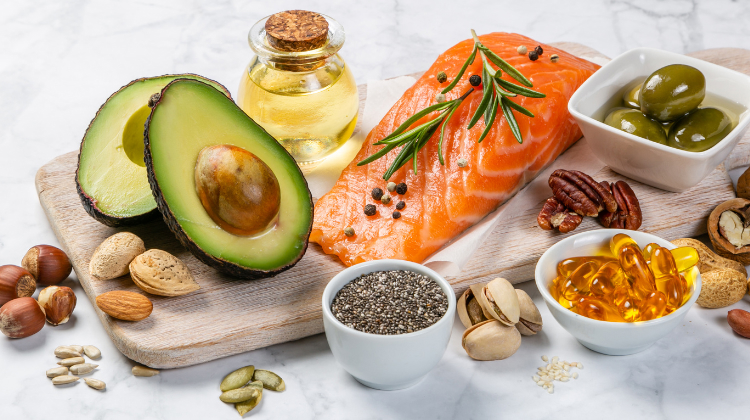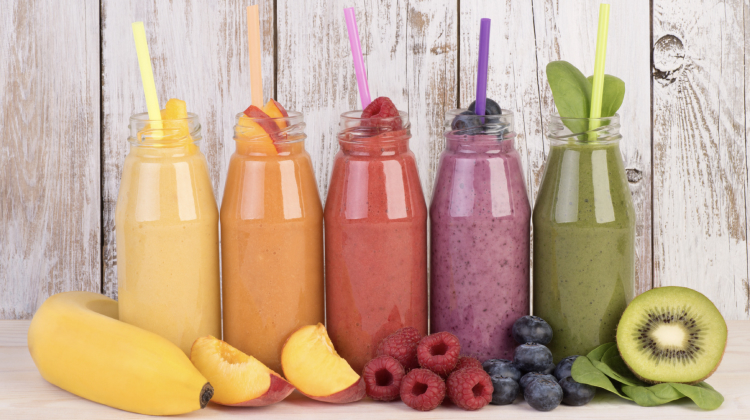Gaining Weight On Paleo Diet 2024: 5 Ways To Assist Weight Gain

The Paleolithic diet, or Paleo diet caught a lot of popularity amongst people looking to fuel their workouts. It was also revered for its aid in weight loss for individuals and other possible health benefits. Although there is limited evidence on the benefits of this diet.
While the Paleo diet can support weight loss, gaining weight on Paleo is also possible. Adjusting the number of calories consumed and your workouts can help you achieve your weight goals, whether it be weight gain, maintenance, or weight loss.
How To Gain Weight On Paleo Diet?
- Increase calories consumed
- Add healthy fats
- Include snacks
- Make smoothies
- Weight training
What is a Paleolithic Diet?
The Paleo Diet[1] (PD) is a dietary plan modeled around foods commonly hunted or gathered by humans who lived between 2.6 million to 10,000 years ago.
This diet stems from the hypothesis[2] that our genes stopped evolving 10,000 years ago and our bodies are not designed to process the modern diet. It assumes that this is the main cause of chronic disease.
Supporters of PD believe that eating like our Stone Age ancestors might improve health and prevent chronic disease.
The foods are mainly limited to: (this is not a comprehensive list)
- Meat (beef, pork)
- Poultry (chicken, turkey, eggs)
- Game (duck, venison, buffalo)
- Fish (salmon, trout, …)
- Fruits
- Vegetables
- Tubers (potatoes, sweet potatoes,…)
- Fats from fruits (olive oil, coconut oil, avocado oil,…)
- Honey
- Nuts and seeds
People following PD avoid:
- Dairy (milk, cheese, yogurt,…)
- Grains (wheat, sorghum, rice, quinoa,…)
- Legumes (lentils, beans, …)
- Salt and refined sugar
- Processed foods
- Alcohol
Pros
This diet promotes the consumption of fruits and vegetables, which is a great addition to any healthy diet and for maintaining gut health. Additionally, it eliminates refined sugar and processed foods, which may also have positive health benefits. This is especially true if you are overweight, have diabetes, or have heart disease.
Eating paleo may result in you incorporating more variety of foods. It can also help you eat more fresh and less processed food items. Some people might find this makes them feel better overall.
Cons
It eliminates grains which are a good source of fiber and energy and also may have some antioxidant power. And by not including dairy, might deprive your body of calcium.
This diet can also be difficult to stick to. PD eliminates entire food groups, which makes it difficult to follow this diet long-term. PD also does not allow plant proteins, which may be more economically accessible calories for many people. Since it also eliminates salt, adherence can drop with time.
Modified options of this diet may be of benefit for those who have a hard time with these restrictions or lack the time to cook everything from scratch. Other modifications could include butter, processed convenience items based on allowed foods, and potatoes.
Benefits to Health
One article[3] tried to find the effect of PD on cardiovascular risk factors, but could not show conclusions on the data. They found a significant effect of PD on weight, body max index (BMI), and waist circumference.
When analyzing the effect on blood pressure, total cholesterol, triglycerides, low-density lipoproteins (LDL cholesterol – the “bad cholesterol”), and C-reactive protein (CRP, an inflammatory marker), no benefit could be concluded.
In a small study[4] individuals with Ischemic Heart disease, glucose intolerance, or diabetes were started on PD. Results showed improvement in plasma glucose. If properly balanced, PD could potentially promote glucose management for people with Type 2 diabetes or prediabetes.
As with any diet, consult your medical doctor or a Registered Dietitian before implementing it. This diet in particular may not be a good alternative for people with insulin-dependent Type 1 Diabetes Mellitus, pregnant individuals, or those with a history of eating disorders. This is mainly due to the particular low-carb focus of PD and the elimination of complete food groups.
Can Paleo Diet Help You Lose Weight?
The PD plan might just do that. A short-term study[5] showed that the PD dietary plan may help you lose weight and decrease BMI and waist circumference. There is not much evidence showing the long-term effects on health while following PD, but when implemented it appears to support weight loss.
This diet may be also helpful to improve satiety. A small study[6] showed the potential of meal plans created following PD principles to improve satiety. People in the study consumed more plants at meal times and showed an increase in gut hormones involved in satiety. This could mean that you will feel full while following PD.
All in all, PD could help you shed extra weight. Avoiding foods that have hidden calories like processed foods with added fat or sugar, you might achieve a calorie deficit. Including more fruits and vegetables will also support satiety and help you eat less.
If you are not losing weight while on the paleo diet, consider decreasing the portion sizes of high-calorie foods. Eat fewer oils, coconut, nuts, and seeds. Add more vegetables to your plate, this will fill you up. Finally, size down your plate, choose lean proteins, and portion your tubers. All these can help you shed body fat and achieve a healthy weight while eating paleo-friendly foods.
How To Gain Weight On Paleo Diet? 5 Ways To Try
If you’re looking to gain weight on Paleo, here are some things you may want to practice:
Increase calories consumed

For weight gain to be achieved a calorie surplus is needed. This means you’ll need to eat more calories than what your body needs to maintain its weight. Although PD doesn’t allow grains like brown rice, it includes some other high-calorie foods like sweet potatoes to support weight gain.
You can also increase the amount of food consumed on your plate or in between meals.
If you are following a modification of PD, you can also use a protein powder such as a pea protein powder to boost your daily calorie intake.
Add healthy fats

PD allows for some healthy fats like avocado, olives, and their oils. You can add these to your food while cooking and to your vegetables to help you absorb their nutrients. You can also top your smoothie bowls with nuts and coconut shavings, for a boost of flavor and calories.
It’s important however to not overuse grass-fed butter, coconut, or palm oil. The Paleo diet might already be high in saturated fats from animal protein, and adding too many additional oils can bring you over your daily healthy limit.
Exceeding the American Heart Association[7] recommendation of around 13 grams per day could put you at higher risk for heart disease, so moderation is key.
Include snacks

The possibility of experiencing higher satiety with meals may decrease the number of calories you consume. Snacks can be a good inclusion to your diet to sneak in extra calories. Some healthy snacks to bump up calories are nuts, almond butter, peanut butter, and dried fruit.
Top some fruits with nut butter, create a homemade trail mix or keep it simple with ants on a log (celery sticks topped with nut butter and raisins).
Make smoothies

Smoothies have become popular and also aesthetic in the case of smoothie bowls. These can be crafted to be a good pre-workout energy boost or a satisfying post-workout snack for recovery. They can also be considered liquid calories to help achieve your calorie surplus and support weight gain efforts.
Make fruit smoothies and add seeds like flaxseed or nuts like walnuts for more omega-3 anti-inflammatory fats and calories. If you are making a smoothie bowl, use fun fruits and vegetables like berries, kiwi, or spinach to add color to it. Finally, top your bowl with nuts, seeds, coconut shavings, dried fruits, coconut oil, and/or fresh fruits.
Coconut milk or almond milk can be used as a base for your smoothies. If so, you can make peanut or almond butter shakes in a variety of flavors.
Weight Training

Muscle building can also help you gain weight on Paleo. Include weight training in your routine at least 3 times a week to increase muscle mass. Bulking while on paleo is possible, although there is no evidence that PD improves performance[8] in athletes, it might help you gain weight.
Muscle training is a good way to promote changes in your body composition, help you increase muscle, and burn more calories and fat.
The Takeaway
The paleolithic or caveman diet is a really popular fad diet. Although it has many followers, there’s not much evidence scientific evidence that it may solve health problems.
However, based on its characteristics, it may have the potential to decrease metabolic risk factors like obesity and blood pressure if done correctly. Calcium supplementation may also be needed since it’s not a balanced diet.
As with any diet, if practiced consistently, it may help individuals achieve their particular healthy weight goals. PD can also be an avenue to learn healthy habits and naturally include more whole, minimally processed foods into their diets.
+ 8 sources
Health Canal avoids using tertiary references. We have strict sourcing guidelines and rely on peer-reviewed studies, academic researches from medical associations and institutions. To ensure the accuracy of articles in Health Canal, you can read more about the editorial process here
- Pitt CE (2016). Cutting through the Paleo hype: The evidence for the Palaeolithic diet. Australian family physician, [online] 45(1). Available at: https://pubmed.ncbi.nlm.nih.gov/27051985/
- Turner, B.L. and Thompson, A.L. (2013). Beyond the Paleolithic prescription: incorporating diversity and flexibility in the study of human diet evolution. Nutrition Reviews, [online] 71(8), pp.501–510. doi:10.1111/nure.12039.
- Ghaedi, E., Mohammadi, M., Mohammadi, H., Ramezani-Jolfaie, N., Malekzadeh, J., Hosseinzadeh, M. and Salehi-Abargouei, A. (2019). Effects of a Paleolithic Diet on Cardiovascular Disease Risk Factors: A Systematic Review and Meta-Analysis of Randomized Controlled Trials. Advances in Nutrition, [online] 10(4), pp.634–646. doi:10.1093/advances/nmz007.
- Lindeberg, S., Jönsson, T., Granfeldt, Y., Borgstrand, E., Soffman, J., Sjöström, K. and Ahrén, B. (2007). A Palaeolithic diet improves glucose tolerance more than a Mediterranean-like diet in individuals with ischaemic heart disease. Diabetologia, [online] 50(9), pp.1795–1807. doi:10.1007/s00125-007-0716-y.
- Österdahl, M., Kocturk, T., Koochek, A. and Wändell, P.E. (2007). Effects of a short-term intervention with a paleolithic diet in healthy volunteers. European Journal of Clinical Nutrition, [online] 62(5), pp.682–685. doi:10.1038/sj.ejcn.1602790.
- Bligh, H.F.J., Godsland, I.F., Frost, G., Hunter, K.J., Murray, P., MacAulay, K., Hyliands, D., Talbot, D.C.S., Casey, J., Mulder, T.P.J. and Berry, M.J. (2015). Plant-rich mixed meals based on Palaeolithic diet principles have a dramatic impact on incretin, peptide YY and satiety response, but show little effect on glucose and insulin homeostasis: an acute-effects randomised study. British Journal of Nutrition, [online] 113(4), pp.574–584. doi:10.1017/s0007114514004012.
- www.heart.org. (2021). Saturated Fat. [online] Available at: https://www.heart.org/en/healthy-living/healthy-eating/eat-smart/fats/saturated-fats.
- Frączek, B., Pięta, A., Burda, A., Mazur-Kurach, P. and Tyrała, F. (2021). Paleolithic Diet—Effect on the Health Status and Performance of Athletes? Nutrients, [online] 13(3), p.1019. doi:10.3390/nu13031019.



